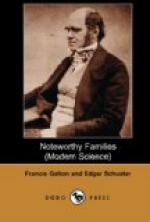In order to test the question, I marked each noteworthy person whose name occurs in the list of sixty-six families at the end of this book with 3, 2, or 1, according to what I considered his deserts, and soon found that it was easy to mark them with fair consistency. It is not necessary to give the rules which guided me, as they were very often modified by considerations, each obvious enough in itself, but difficult to summarize as a whole. Various provisional trials were made; I then began afresh by rejecting a few names as undeserving any mark at all, and, having marked the remainder individually, found that a total of 657 marks had been awarded to 332 persons; 117 of them had received 3 marks; 101, 2 marks; 104, 1 mark; so the three subdivisions were approximately equal in number. The marks being too few to justify detailed treatment, I have grouped the kinsmen into first, second, and third degrees, and into first cousins, the latter requiring a group to themselves. The first degree contains father and brothers; the second, grandfathers and uncles; the third, great-grandparents and great-uncles. The results are shown in Table VI. The marks assigned to each of the groups are given in the first line (total 657), and the number of the noteworthy persons in each group who received any mark at all is shown in the third line (total 329). In order to compare the first and third lines of entries on equal terms, those in the first were multiplied by 329 and divided by 657, and then entered in the second line. The closeness of resemblance between the second and third lines emphatically answers the question to be solved. There is no significant difference between the results of the marked and the unmarked observations. The reason probably is that the distribution of triple, double, and single marks separately is much the same in each of the groups, and therefore remains alike when the three sets of marks are in use at the same time. It is thus made clear that trouble taken in carefully marking names for different degrees of noteworthiness would be wasted in such a rough inquiry as this.
TABLE VI.—COMPARISON
OF RESULTS WITH AND WITHOUT
MARKS IN THE SIXTY-FIVE FAMILIES.
____________________________________________________________
_______
| | | | |
| | | | First
| Second | Third | First | Total | |
| Degree.| Degree.| Degree.| Cousins.|
| |______________________|________|________|________|__
_______|_______|
| | | | |
| | |Number of marks | 225
| 208 | 102 | 122 | 657 | | assigned
| | | | |
| |______________________|________|________|________|___
______|_______|
| | | | |
| | |Number of marks |
| | | | | | reduced




